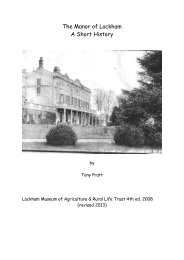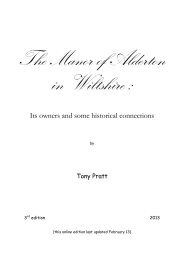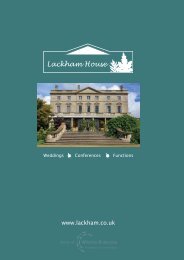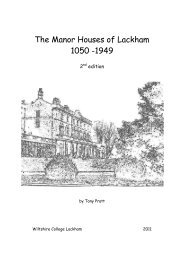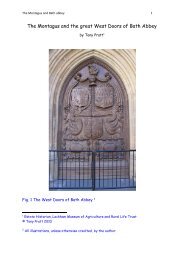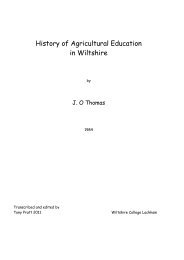The Historical features of Lackham Woods - Lackham Countryside ...
The Historical features of Lackham Woods - Lackham Countryside ...
The Historical features of Lackham Woods - Lackham Countryside ...
Create successful ePaper yourself
Turn your PDF publications into a flip-book with our unique Google optimized e-Paper software.
coppicing etc. <strong>The</strong>se are more troublesome to date but I see no reason<br />
why they shouldn’t be relict medieval boundaries for the “vill” at <strong>Lackham</strong><br />
<strong>The</strong> coppice itself, although I don’t see any direct evidence for it being<br />
ancient, is probably replants <strong>of</strong> the medieval and Tudor system<br />
<strong>The</strong> winding paths evident on the maps are certainly at least 18 th century<br />
and are part <strong>of</strong> the start <strong>of</strong> the change in use <strong>of</strong> the woods from entirely<br />
functional productive units to being also part <strong>of</strong> the “aesthetic”<br />
attraction <strong>of</strong> the estate, walking through nature as opposed to working<br />
with nature you might say. Obviously the woods were, and indeed<br />
continue to be, both but the balance swings backwards and forwards. In<br />
the 17-18 th centuries it was mostly functional with some leisure, in the<br />
nineteenth much more to do with leisure and today back more towards<br />
production. I think it is not unreasonable to claim that the shooting<br />
interests are leisure in the 19 th early 20 th centuries (it certainly was for<br />
the lord <strong>of</strong> the manor and his / her chums) whereas today the shooting is<br />
productive as the shoot is run in part as a commercial enterprise.( what<br />
do you think?)<br />
<strong>The</strong> “Hornbeam Walk” is late 18 th to mid nineteenth century in date and is<br />
definitely in the area <strong>of</strong> “aesthetic”.<br />
<strong>The</strong> Lime Walk and the broad “ride” that runs from the river north west<br />
to the south edge <strong>of</strong> the Playing Field are both <strong>of</strong> about the same date<br />
(?) and again leisure <strong>features</strong>.<br />
<strong>The</strong> “Glade” area in the South Wood, first clearly evident on maps from<br />
about the mid 1850’s is probably also aesthetic in use.<br />
<strong>The</strong> World War II hardened defence structure (Pill box) in the NE<br />
corner <strong>of</strong> North Wood is one <strong>of</strong> the more recent historical <strong>features</strong> <strong>of</strong><br />
the woodland.<br />
Obviously the flora <strong>of</strong> the woods, with indicator species in both extant<br />
woodland and former woodland areas, such as the Spring Garden area<br />
west <strong>of</strong> the Walled Garden, indicate an ancient woodland being in place<br />
over all <strong>of</strong> the existing woodland area, and even wider<br />
Tony Pratt<br />
Garden Staff and Estate Historian 2013




